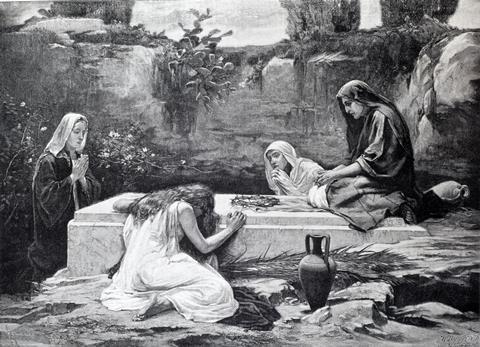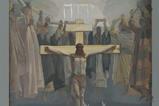Elaine Storkey unpacks the biblical passages that compare the failure of Jesus’ male disciples to stand by him with the faithfulness of the female followers

Study passages: Luke 23:49,55; 24:1-12
It is an old truism that women and men are different. We share very many similarities as human beings created in God’s image, but in many contexts we often see differences in the way men and women react. Some of this can be related to gender experiences; some of might be related to gender expectations. Often, of course it’s linked to the way we conduct our relationships as well as our varied personalities. When we are challenged by difficult situations our different responses can sometimes take us by surprise.
As we think about Easter, we notice striking differences in the way Jesus’ male and female followers responded to the enormous trauma that confronted them. As Jesus faced the terrible ordeal of false arrest, injustice, torture and death, his disciples were stretched to the limit. Yet, when we read the Gospel accounts we can’t help noticing that at so many significant points his male disciples let him down, while the women stayed faithful, watching and caring.
Let down by his male friends
Take the events in the Garden of Gethsemane. Jesus was in emotional and spiritual agony. He faced the reality of what lay ahead of him, knowing the future only too well and needing desperately to have reassurance from the Father. His disciples had gone to the Mount of Olives with him, presumably for support. All he asked of them was that they would stay and keep watch while he prayed. Yet even that was too much for them. Three times he struggled in prayer before God, and three times he went back to the disciples and found them fast asleep. Finally, he urged them to pray for themselves so that they wouldn’t fall into temptation (Matthew 26:41).
The women came to the tomb to anoint a body, and instead were given the task of telling the men that Jesus was risen and alive
In fact, his words were salutary, because almost immediately the soldiers came to arrest Jesus on charges trumped up by some of the religious leaders. The horrible truth was that one of his male disciples had betrayed him. Judas, in an act of treachery, had tipped his enemies off as to the best place to seize him. He had ‘sold’ Jesus into their hands. We don’t really know his motives – many scholars have tried to understand how someone who had been a witness to Jesus’ love and compassion could ever have done that. Yet he did. Judas the disciple became Judas the betrayer and left his own terrifying mark on world history.
But his was not the only act of betrayal that night. It was echoed in a minor way in the actions of all the others. Mark spells it out: “everyone deserted him and fled” (Mark 14:50). One of those male followers was so desperate to get away that his clothes were torn off as he ran. These are sad but awful accounts of failure. Why did they run? It seems that fear made them more concerned to save their own skin than to stand with Jesus. The men close to Jesus certainly didn’t shine, but left him isolated, unsupported and friendless at his great hour of need.
Nor did it end there. Yet another disciple was to prove unfaithful. Peter had certainly done his best. He had attacked one of the arresting soldiers with a sword (and been rebuked for that by Jesus). He had also hung around afterwards, trying to work out what was going to happen and wanting to keep close. But when his own time of testing came, he too gave in to fear. As the trial got underway, he was recognised in the courtyard by a servant girl and others who challenged him as a disciple. Three times Peter denied even knowing Jesus, swearing and cursing in his panic. Then, hearing the crowing of the cockerel he remembered that Jesus had already predicted his unfaithfulness and was mortified (Matthew 26:69-75).
Faithful female disciples
The Gospels tell a very different story in relation to the women disciples. In every Gospel the contrast between the responses of them and the men is marked. Each narrative highlights the women’s devotion and dependability; those women who had followed him from Galilee were not going to leave him now. Even though it must have been heart-wrenching for them, they remained close by as he was subjected to injustice and torture and led off to be crucified. His mother, his aunt and other women followers even stood near the cross along with John, the only male disciple mentioned there. They neither denied nor deserted him but stayed within sight and earshot of Jesus. And he, in terrible pain, showed his enormous compassion by lovingly placing the care of his grieving mother into John’s hands (John 19:25-27).
The women didn’t melt away once Jesus had breathed his last either. They followed Nicodemus and Joseph of Arimathea who had asked for Jesus’ body, and they carefully noted the route to the tomb where he had been laid. (Luke 23:55). The day after he died must have been horrendous for them. They couldn’t tend to his corpse – the Sabbath was about to begin and no journey back could have been made. The visual memory of crucifixion, of his suffering and agony, along with their own helplessness would have weighed heavily on their hearts. But they stayed and comforted each other, spending their bereavement together preparing spices to anoint Jesus’ precious body when Sabbath was over. They were not worried about their own safety.
The Gospel writers all relate the details about the women visiting the tomb on the third day. Although none of them cites the same number of women, each author names Mary Magdalene. John tells the story entirely from Mary Magdalene’s viewpoint (John 20:1-18). Matthew mentions that “the other Mary” was also there (Matthew 28:1-10) and Mark says she was the mother of James (Mark 16:1-8). He also adds Salome. Luke includes all the women who had followed Jesus from Galilee, mentioning the various Marys and Joanna by name (Luke 24:1-12). We can conclude that probably half a dozen women went to anoint the body, for there are no contradictions here, just a richness of narrative when we put all the stories together. Each Gospel account speaks of the stone across the front of the tomb having been miraculously rolled away. Each assures us that the women found the tomb empty.
The rest of the stories all contain unique elements. John describes the encounter between Mary Magdalene and Jesus, whom she initially takes to be the gardener. Matthew and Mark both describe the shining angel who confirms the news that Jesus is risen from the dead. In Matthew the women then see the risen Jesus for themselves. Luke writes about two angels who remind the women of the words Jesus had prophesied about his death and resurrection. Yet all the authors record that the women came to the tomb to anoint a body, and instead were given the task of telling the men that Jesus was risen and alive.
I find it almost amusing to read the little postscript that Luke sneaks into his narrative. He tells us what happened when the women did proclaim this message to the male disciples. They didn’t get the greatest reception: “But they did not believe the women, because their words seemed to them like nonsense” (Luke 24:11)! The men’s failure to support Jesus was now compounded by the failure to believe the faithful women’s account of the empty tomb and angelic messengers. So, Peter had to go to see for himself the linen cloths with no corpse. (Note from the editor – sadly this still happens today. Read Dr Belle Tindall’s column on the ‘Believe-Me Gap’, where women aren’t believed as readily as men.)

What can we learn from these accounts today?
The greatest thing we take away from the Gospel stories is the truth of the resurrection. Death and sin has been conquered by Christ’s atoning love and self-giving. Jesus is the victor over evil, and through his death and resurrection we can know the hope of eternal life.
But there are other underlying messages also – that God does not reinforce the prejudices of culture, but chooses whom he will to spread the good news of Jesus in the power of the Holy Spirit. The risen Christ came to faithful loving women, to bless their love and faith and assure them that it had not been in vain. This is extraordinary when we realise how little status women had in those days. It’s clear that even the disciples didn’t see them as equals. The Jewish law stipulated that women could not go beyond the Gentile’s porch in Herod’s temple. A woman’s testimony could not be accepted in law, unless it was corroborated by a man, or by many others. Yet God overruled in all this. He took the risk of making women the first witnesses of the resurrection; choosing and entrusting them with the truth for themselves so they could proclaim the greatest message the world has ever known. Because of the experiences and testimony of women, the wonderful truth of salvation in Jesus has resonated right down the centuries and reaches us here today.


































1 Reader's comment